![]()
The Words The Kwak Family
|
|
The Words The Kwak Family |
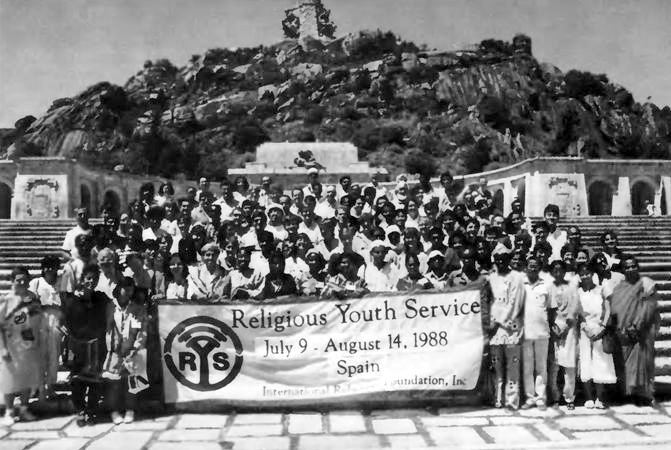
Distinguished guests, honorable visitors, friends of the Religious Youth Service project, ladies and gentlemen:
On behalf of the International Religious Foundation and its founder, the Reverend Sun Myung Moon, I welcome you to the opening of this, the third international Religious Youth Service project.
Spain is a nation with a rich and enduring cultural heritage. As you know, three great religions have helped shape the history and people of this nation: Christianity, Judaism, and Islam. Furthermore, the influence of Spanish culture extends far beyond the borders of this nation to include hundreds of millions of people throughout the world, particularly North, South, and Central America. Therefore, Spanish culture, nurtured by three great religious streams, has a global significance. As you work and study here, you will discover for yourselves the important role religion plays in the lives of the Spanish people.
The Religious Youth Service is now in its third year, and stands on the foundation of the 1986 project in the Philippines and the 1987 project in Portugal. As I have watched the Religious Youth Service develop, I have been profoundly moved by the dedication, idealism, and open-mindedness of the participants. It is perhaps a platitude to state that the future belongs to the youth of this world, but it remains unmistakably true. What the Religious Youth Service seeks to provide is an opportunity for conscientious young people to focus their vitality, their freshness of spirit, and their willingness to give of themselves for the sake of building a better world.
The central conviction of the Religious Youth Service is that religion should play a decisive role in the transformation of our present world and the formation of a future world of peace and prosperity. Young people often embody the spiritual spark that lies at the core of the various religious traditions. Moreover, the young have a vision of the world that aspires to the elimination of artificial barriers that separate peoples, cultures, races, and religions.
The age we live in is truly emerging as a global age. The reality of our being inhabitants of a common planet is becoming increasingly apparent to all. Recent developments in communication and transportation only make this global consciousness all the more obvious. People travel from one country to another easily and conveniently in remarkably short periods of time. We communicate around the globe as easily as we can with members of our own town or village. Current news from any part of the world can reach even remote villages in a very short period of time.
Yet we must also recognize that profound divisions still exist. While news from all parts of the world is readily available, what are most often communicated through the news media are the various conflicts, disturbances, and wars that occur around the world. These only remind us of the barriers, resentments, and hatreds that still divide people. While science and technology have provided the conditions for a kind of external global unity, humanity remains sadly divided. From Rev. Moon's perspective, the unity of the world has its fundamental foundation in the unity of God. Humanity has its origin in God. But why then does the world not manifest the unity that is God's nature? This is of course a complex theological question, which time does not allow me to discuss at length. Suffice it to say that the disunity of the world exists in proportion to our disunity with God. Thus, at the most fundamental level, the disunity of the world is a spiritual problem. Therefore, the transformation of our world must involve the spiritual transformation of each human being.
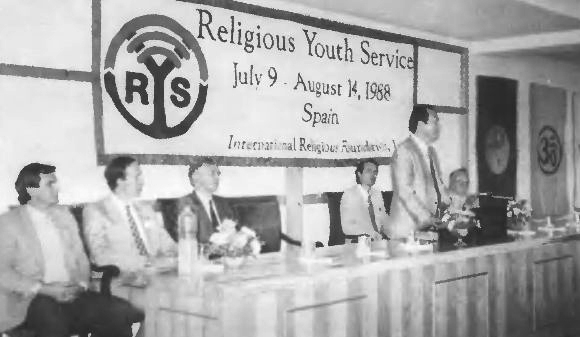
Rev.
Kwak invites the young volunteers to challenge themselves spiritually
as well as physically.
As all religions teach, this is no easy task. The religious life involves a challenge that too few people take seriously in our world today. Furthermore, the ability to combine religious commitment with an openness to others is an ideal that has seldom been attained.
That is, many devout religious people have fallen prey to a dogmatism that hinders the work of the spirit of God.
The ideal of a peaceful and unified world is an ideal that God shares with each of you. In fact, that ideal originates with God. Each of us is called upon to carry out that ideal on behalf of God. If you will, we are each God's ambassadors. I want to invite each one of you, as participants of the Religious Youth Service, to think of yourself as an ambassador of God. But, you do not come as a loud, arrogant, or boastful ambassador. Rather you come in the same manner as did all of God's central figures. That is, you come wearing the shoes of a servant and with the loving heart of a parent. You come to serve and to give, not to take or seek your own benefit. You teach by your actions, namely your service and the fact of your having overcome the barriers that have divided people throughout human history. You teach by example. In this way, you are the spiritual leaders that God needs to implement the ideal that we all share: a world of unity, peace, and love.
This gathering represents a truly historical event of great importance. It is not that we are such a large or even distinguished gathering. Rather, the significance of this gathering lies in the spirit and purpose of our coming together. For, unlike many gatherings in the world, we are gathered to serve. Certainly we are here to serve with our hands and our sweat, as well as to learn from the people we meet. More importantly, however, we are here to serve the ideal of a God-centered world culture, a culture that is nurtured by all the different races, nationalities, and religious traditions of the world.
During your stay here in Spain you will enjoy a wide range of experiences: hard physical work, cultural enrichment, interpersonal relationships, and spiritual growth. On each of these levels you will face challenges. Your physical endurance will be tested at times. Likewise you will be forced to adjust to a culture perhaps very different from your own. Even the interaction among the RYS participants will be challenging at times. But perhaps your greatest challenge will be a spiritual one, the challenge to extend your spiritual horizon to a greater appreciation of the love of God and of the need to transform our world. For this task, please utilize the resources of your own tradition and at the same time open yourselves up to the traditions of others. Together let us move toward that place which many call the Kingdom of God. The Kingdom of God is the place where selfishness does not exist. It is a place where love and service toward others is the norm. Through this project, we will be creating the Kingdom of God in our own hearts and in the hearts of those we meet.
May God bless you. Thank you very much.
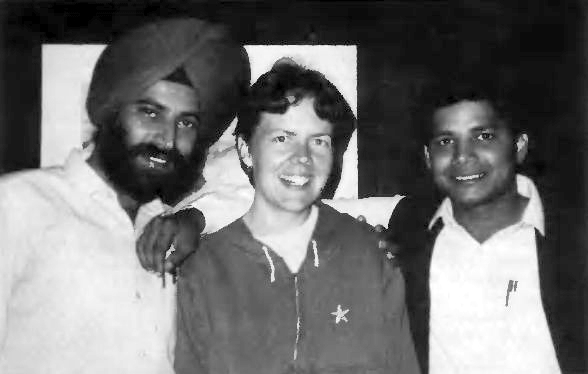
Mimi
Allen with two newly-made friends.
This summer, young people from all over the globe gathered together in Spain for the third annual Religious Youth Service project. The project, sponsored by the International Religious Foundation (IRF) and the International Relief Friendship Foundation (IRFF), was inspired by Father for the purpose of promoting inter-religious I harmony through dialogue and cooperative service.
For the first time, this summer's project began with a unique three-day leadership seminar for all the site leaders, assistant site leaders, nurses, and group leaders. This was enthusiastically led by- site leaders Dr. Ron Burr and his wife Sherry from Southern Mississippi State University. In these first days, the staff had a chance to get to know one another, discuss leadership styles, learn new options for leadership, and prepare for the arrival of the other 75 participants from over 40 nations. There was a real sense of excitement in the air as the participants arrived beginning July 9 for the orientation program, which was held about 20 miles from Madrid in the city of Escorial, famous for its royal palace.
Many of the participants had already heard amazing testimonies of the RYS experience from friends who had participated in the previous two projects in the Philippines and Portugal. For all of us, it was an indescribable feeling getting to know so many people from different countries in those first few days. Most made new friends almost immediately. Also on hand was an impressive group of nine special advisors, professors, and religious leaders from all the major religions, who were present as elders to greet the young people from the various faiths.
Our first week was packed full of activities, ranging from interfaith morning prayers to swimming to Spanish lessons. One of the first main gatherings was a welcoming banquet at which Rev. Chung Hwan Kwak, president of IRF, shared his vision and hope for the project. He shared that by working on this project we were "God's ambassadors," serving the ideal of a God-centered world culture, a culture that is nurtured by all the different races, nationalities, and religious traditions of the world."
Almost every day of the orientation week a lecture was given by a guest speaker or one of the distinguished RYS advisors. Dr. Francis Clark, senior consultant for IRF, had a unique way of bringing his audience into full participation with his talk, "Approaches to the Sacred." "The Mystics of Spain and Comparative Mystics" was given by Dr. Antonio DiNicolas, who had some fascinating personal insights into the subject of mysticism. Ambassador Emelio Beladiaz spoke on ''The Cross Currents of Cultures."
Visits to historical, cultural, and religious sites were also an important part of the week. We traveled to the city of Segovia, where Roman aqueducts have stood for nearly 2,000 years. We went to the famous Prado Museum in Madrid and to the town of Avila, where the 16th century mystic St. Teresa lived and taught. We also went to a place called Los Caidos, a huge and majestic monument in the mountains that was built by prisoners, under the order of Premier Franco, to commemorate the fallen soldiers of the Spanish Civil War.
At Los Caidos a special event was held: an inter-religious prayer and meditation service. RYS representatives, clad in either their native costume or special religious attire, united together in prayer to form a colorful and beautiful representation of the religious youth of the world. Some bowed their heads, some clasped their hands together, some removed their shoes, some covered their heads, some burned incense, some chanted, some read, some sang, some shouted proudly the name of God -- all were united, however, in a deep spirit of love and brotherhood.
By the end of the orientation week, already many friendships had blossomed. Although new friends had to be left behind for now, there was excitement about getting down to work on the projects. Buses began loading for the trip to southern Spain where the work would take place. One group, led by the Burrs, headed for Sevilla. A second group, led by Dr. Michael DeArmey, also from Southern Mississippi State University, headed with his wife Susan for Baza. A third group, led by Dr. Ed Warner, an instructor at Indiana State University, and his wife Sue, headed for Almeria. All of us were full of hope and expectation as we left Escorial for a very different part of our RYS experience.
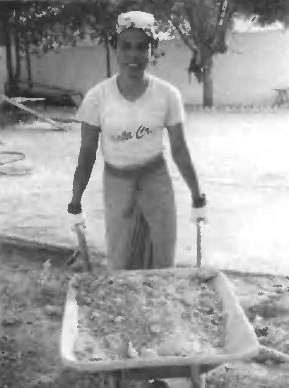
Bhikkhu
Lokananda from Bangladesh became known for his hard work at the Baza
site, where a school building was converted into a food distribution
center.
Sevilla is located on a vast agricultural plain. The majority of the local people make their living as migrant farm workers. They have to travel long distances from their homes to their places of work, and a serious problem thereby arises: Since both parents usually work, the children are often left at home alone, even children under school age. So in Sevilla the RYS project was to construct a daycare center for these children as well as a facility which will provide lunches for them. The project was suggested by social workers and the regional government. A secondary project done by the Sevilla group was the completion of a senior-citizens center in Burgillos, a small town just outside of Sevilla. This building had already been started, but the RYS volunteers finished it.
The Sevilla group had the opportunity to have their bus "blessed." They happened to be there during the festival of St. Christopher, when traditionally the townspeople drive through the town in their vehicles to have them blessed by the local priests for safety in the coming year. Our RYS volunteers drove into town and were able to be included in the procession and receive the blessing from the local priest! As the bus drove through, the townspeople marveled at how many colors, races, and nationalities were represented, and the people applauded them with great enthusiasm.
At the Sevilla group's farewell banquet and closing ceremony, the volunteers were introduced to an old man who would be the first to live in the senior- citizens' center they had built. This experience made all the volunteers feel on an internal zeal that the work they had done was of real and lasting value.
In Baza, the site of the second group, there is a large community of Gypsies living in mountainside caves. The majority of these people are unemployed and poverty-stricken. They rely on food assistance from the city government's food distribution center, but its location is very difficult for the Gypsies to reach. In cooperation with the town hall and a local social worker, the Baza group converted an old school building no longer in use into a new food distribution center. It is located at the foot of the mountain and is easily accessible.
Having an opportunity to get to know the Gypsies was a life-changing experience for those of us in the Baza group. Seeing them break out in song and dance at almost every opportunity was fascinating, and at times our group participated. Seeing the water some of them lived literally in "holes in the wall," with no running water, electricity, or furniture, was another reminder that although Spain is not generally considered a developing nation, there are poor people everywhere. This knowledge reaffirmed to all the participants that their work was greatly needed.
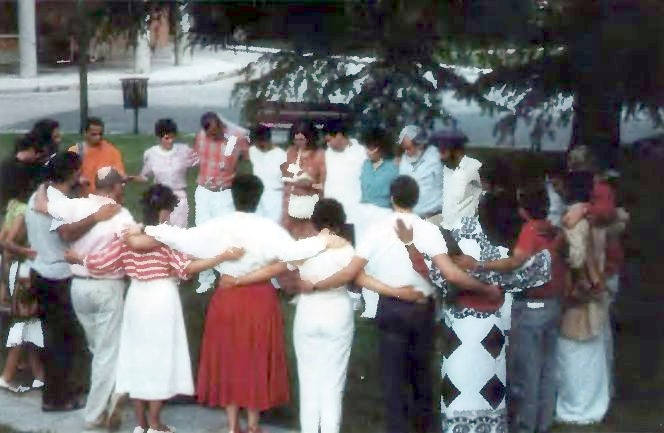
Every
day started with a prayer.
Although most of us knew no Spanish, it was heartwarming to see how the local children always managed to communicate with us. They came every day faithfully to watch what was going on, play around us, try to help out, and sometimes help themselves to a few leftovers from breakfast. One impromptu project that took place in Baza was bathing children. Some of the kids looked as if they had never had a bath or combed their hair in their entire lives! It was quite a sight to see, especially when one little girl's matted, knotted hair was transformed into a beautiful shining French braid with a red ribbon.
Every participant at the Baza site had an unforgettable time building this food distribution center. It became more obvious each day the group was there just how necessary this building was for the people.
The third project took place outside of Almeria in a small town called Nijar, where an important drug rehabilitation center is located. It is the only center of its kind in the region. Like many other countries throughout the world, Spain also faces a problem of drug abuse. This particular facility had many needs, but it was decided that we would construct a training hall where trades could be taught, such as carpentry, welding, and ceramics, which could help the young men going through drug rehabilitation to adjust to normal life after leaving.
Many of our participants admitted afterwards that before reaching Nijar they had many fears about working with drug addicts, but after getting to know them, their fears disappeared. One participant commented that they weren't at all what she had expected; they were men that could have been her brothers.
The name of the rehabilitation center is Milagrosso, which means "miraculous." The directors of this program commented that they truly felt it was a miracle of God that they could receive so many young people from all over the world to help them. According to the volunteers, two nuns seem to be the life force of this center: Sister Pepita, who works full time in the center, and Sister Delores, who works all day in a hospital and then all evening in the center. The RYS site nurse Catherine Capelli said that the two women were always full of hope and joy even though they slept only three or four hours a night. Another participant, Anne Marie Gonzalez from Brooklyn, New York, was so inspired by the nuns that she plans to return to help them during her Christmas vacation this year.
Sharing our Convictions The service work was a life-changing experience, but so was the inter-religious dialogue. Every participant had the opportunity to share his or her deepest convictions and to answer questions of the others. Our daily schedule was set up to provide an opportunity for work, discussion, and free time. Wake-up was early so that we could complete as many work hours as possible before the hottest part of the day. Most found it challenging to rise before sunup after days of hard work. A team spirit developed, however, and it soon felt as if we were one family helping one another get ready for each new day.
Driving on the bus and watching the dawn break over the hills was a memorable experience. Just as the sun was rising, the new day of work would begin with a prayer. Usually the work day went from 7:00 a.m. to 12:30 p.m. with a half-hour break for breakfast. In many cases participants would stay longer to either catch up on unfinished work from the previous day or to receive supplies, such as bricks or other materials, that came in by truck.
The sun in southern Spain can get extremely hot, and the temperature often does not drop below 95 degrees Fahrenheit (35°C) all day and can climb to 110 degrees Fahrenheit (43°C). For this reason many participants quickly adapted to the Spanish tradition of taking a siesta. Afternoons were mostly free except for occasional meetings. Each evening the group would assemble for a talk given by a participant on a topic of his or her choice. Some chose to speak about their religious beliefs; some spoke about political, social, or moral issues; some showed slide shows or presentations on their homeland or culture; some gave dancing or music lessons. It was enriching for all.
It was quite phenomenal to think that representatives of different races, religions, and nations, who have not only been historical enemies but are still killing each other in wars today, were present together sharing peacefully their ideas, hopes, and dreams. All of us felt incredible hope for the future of the world. Even without words to express our sentiments and emotions, everyone was beginning to feel deeply the real purpose of the Religious Youth Service. Getting to know people by living in close quarters, praying together, sweating together, laughing together, crying together, and rising up early every day together fostered deep and meaningful relationships.
One day a young man from the community in Baza came in tears to the volunteers he had gotten to know. His best friend had been killed the day before in a car accident. He asked for our prayers and wanted to know if someone could explain to him why this had happened. It was a serious moment; we were all faced with questions about death and dying. The group decided to first have a moment of silent prayer, and then we all discussed our various views about life after death. Throughout the project, we shared every aspect of our lives with each other. It was hard to think of someone as black or white, as Jew or Muslim, as South American or Chinese; we were just Henry, Sharon, Eduardo, and Nawaal.
A weekend trip to historic Granada was organized to reunite all the participants who had been separated for two weeks at the three work sites. There the group took a trip to an architectural wonder, the Alhambra, a magnificent Arabian palace built in the 17th century. The entire group also participated in what we called the "pilgrimage of life." We climbed the Sacromonte, a hill in the old part of Granada, pausing at different locations to share reflections, prayers, or readings on one of the various stages of life: birth, childhood, adolescence, adulthood, old age, death, and resurrection.
Hearing these readings on the common stages of life of all human beings made it more clear to all of us how similar we are as children of God.
The last work week seemed to fly by, as participants began making plans for going back home. For the last week of the project we traveled to Toledo. Special lectures to prepare the participants for going home and to help them internalize some of their experiences were delivered by Dr. Francis Clark and Father Frank DeGraeve, a Jesuit priest and educational counselor for RYS. The atmosphere became more serious as people prepared for their good-byes. One participant commented that the level of friendship he developed over the few weeks he spent at RYS normally would have taken him years.
On the days of departure, many shed tears. Addresses were shared, and many of us carried home gifts from our new friends from all over the world. Each time another van or car pulled out, it became more painful to say good-bye. We were all sad to go, but at the same time we each felt that a great foundation for hope had been laid. Each participant became a living testimony to the world that peace in the midst of religious and racial conflict is indeed possible.
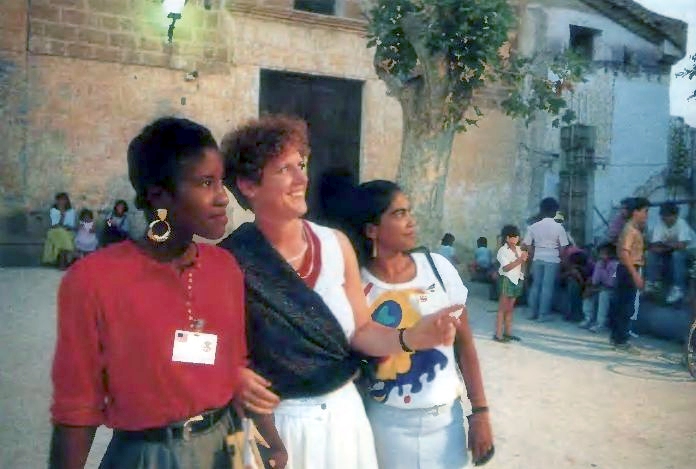
Catherine
Cappelli visits the town square in Nijar with two of her RYS sisters.
A student and a nurse at UTS, Catherine Cappelli was part of the third work group, which helped construct a building in a drug rehabilitation center.
Many of us were full of apprehension and anticipation as we first drove down the long driveway to our site at Milagrossa in southern Spain. In the midst of desert wilderness, surrounded by awesome mountains, we saw a small white building with a large banner welcoming RYS. The staff and rehabs (the male patients) came out and welcomed us all with warm handshakes and kisses to both cheeks.
Milagrossa translated means "miraculous." The history of this drug rehabilitation center is a wonder in itself. With a sum of bequeathed money, Sister Delores, the nun in charge of the center, together with Maxi, the vice president of a local Catholic charity, managed to scrape enough together to establish a foundation for a most needed drug rehabilitation center. At first they were faced with a hostile response from the neighboring towns, who didn't want a drug center in the community. Not only this, but the local banks didn't want to finance them. With the help of God, bit by bit, they were able to win the support of the local townspeople, and by establishing greenhouses they were able to finance the center. Two members representing the Religious Youth Service had walked into Maxi's office earlier in the year and offered the help of RYS to build a training hall for the young men at the center to learn trades such as carpentry, welding, and ceramics.
Later that summer, 35 of us, representing 21 different nations, arrived at Milagrossa. Most of us had never experienced hard physical labor. We woke up at 5 a.m. so that we could do most of the work before the sun became too intense. One of my duties as the site nurse was to maintain fluid levels. While doing my rounds offering water, my heart was moved to see Ed Warner, our site director and a professor of world religions, wrestling with a jackhammer to dig the foundations for our building. Next to Ed was Nancy, working like a Trojan. On the truck was Anne Marie, only five feet tall, unloading all the heavy bricks. As I looked around, I saw that everyone was so diligent in their efforts. Side by side there were Jews, Arabs, Hindus, Buddhists, Mormons, and so on. Amid the scorpions and bricks we shoveled dirt and discussed world problems. We forgot our religious and racial differences. In the pits we developed a sense of communion and camaraderie that will not be forgotten.
The people of Milagrossa worked together with us. Though communication was difficult, we overcame with the use of our dictionaries and sign language. For the people of this community, this was no ordinary building. For them it represented a new beginning and a new life. Most of the men at the center had supported their drug addiction with crimes such as theft, smuggling, and drug dealing. Some of them had been imprisoned up to 20 times. They were astounded to see young people from all over the world give up their summers, their families, their jobs, their studies, and their friends to come and construct a building for them. They kept asking, "Why are you doing this?" According to Maxi, in his closing speech at our final dinner, our presence at Milagrossa brought the realization that "brotherhood and sisterhood, solidarity and mutual help among people of different races and cultures of the world, is really possible."
He continued on to say, "You have shown by our example that obstacles and difficulties can be overcome."
By all means we had our struggles. The supplies didn't arrive until four days before we were scheduled to leave. When they did, Jonathan Tsevi, our site assistant, immediately mobilized our crew to work in rotating shifts. Nearly everyone volunteered to keep working rather than take a siesta. God worked another miracle and the building was erected in just four days. We were united by our belief that we could do it and our sincere desire to serve this community.
According to Maxi, "The men of Milagrossa came to learn the value of the love of God and the love of one's neighbor, to give freely without expecting anything in return." However, it wasn't only the men of Milagrossa that came to realize this. Each one of us came to a deeper reawakening of our spiritual lives.
Though we expected nothing in return, we gained so very much. Many testified that they were able to realize that God works through other religions, that God is beyond dogma, and that He is working through each one of us to help create world peace and bring in the Kingdom.
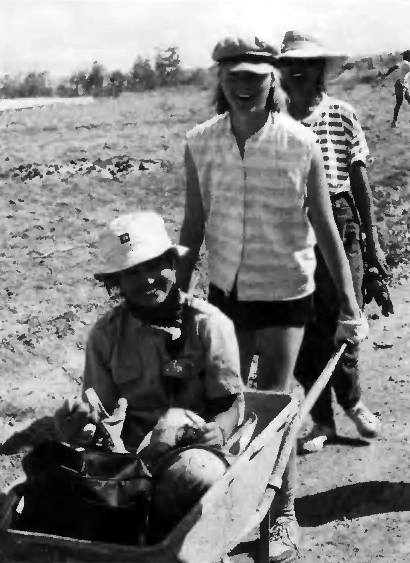
A
short respite from the heavy work at Milagrossa
As Pramod, one of our brothers from India, testified, "A small pebble when it is thrown into the calm water creates a ripple effect, which reaches to the far end. In the same manner we, the small pebbles, will go back to our countries to create waves of religious harmony and racial brotherhood, which will reach to eternity."
When we departed from the people of Milagrossa, and a week later said our good-byes to one another, tears streamed down our faces. These tears represented the victory of our unity and the success of our poignant venture. It was a soul-stirring sight to see a Catholic nun, Sister Delores, crying in the arms of a Jewish Israeli, Jonathan Tsevi, when it was time to say good-bye.
Pramod said, "I remember the first week when we knew one another by name tags. Now we are good friends, acquainted with each other's religion, culture, and lifestyle. One special thing about these relationships is that they just happened.
We did not consciously try to build relationships. It was the natural instinct of the Divine Will that we became closer. We belong to different religions, cultures, and nations, but all those dividing walls seemed to be broken down. We are all the children of God and so brothers and sisters."
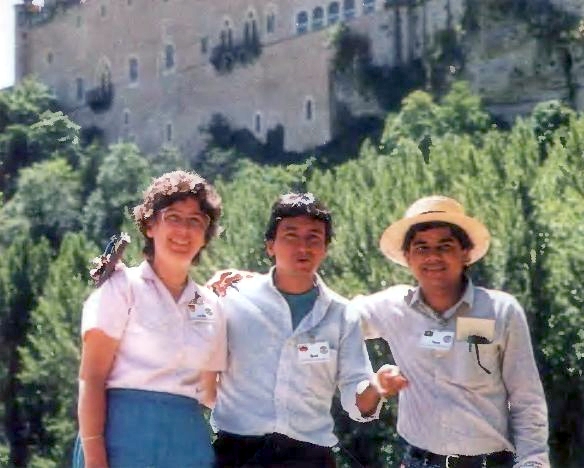
Lydia
Bennett and two RYS participants outside a castle in Segovia.
Lydia is a city leader in Duluth, Minnesota.
This year was the second time I have been a part of the Religious Youth Service. I participated in last year's project in Portugal. Since that time I have developed deep friendships with some of the people I met there. These relationships have taught me about the spirit within each human being and that through the spiritual reality we can be closely connected to each other, even if we are not physically together all of the time.
It was with great excitement that I anticipated working with this year's project in Spain, knowing that so many possibilities could develop. What always fascinates me the most, although it is also the greatest challenge, is the opportunity to come in contact with new people. I knew that I would not meet just any kind of people in Spain; I would meet young men and women who are interested in change -- interested in giving their best to find new ways to create a better future for the world.
My journey to Madrid started from Minneapolis on July 3. It was extremely hot in Minneapolis, but I knew it would be even hotter in Spain, especially in Sevilla, my final destination. Heat is difficult for me to take. I knew the heat was waiting for me, but also new friends, and I could not meet one without the other. I decided to make the best of the circumstances and enjoy the whole experience.
All the staff members met before the rest of the participants. I attended as staff in the position of nurse. In our initial meetings we discussed the project and our ideas on how to make the entire experience the best it could be for all participants. Ron and Sherry Burr gave inspiring and helpful guidelines for our work. For me, the most important lessons were in interpersonal communication, concerning listening well to others as well as maintaining a "listening check," making sure that the message was understood. These were valuable points for all of us to take home.
Over two days, almost all the participants arrived in Madrid and were immediately transported to the scenic and historical town of Escorial, where we convened for our orientation as a whole group of 120 people from over 40 nations. The religions represented were Buddhism, Hinduism, Jainism, Zoroastrianism, Christianity, Islam, and Judaism.
One of my most powerful experiences during the project happened the first week of the orientation through one of the lectures. The topic of the lecture was "Religious Intolerance," delivered by Dr. Braulio Justel Calabozo, professor of Islamic Studies at the University of Cadiz. I was struck when he explained, "Religion should not stand above human beings." Why did he say that? What does this mean to me? With these two questions in my mind, we traveled by bus to the Sierra de Guadarrama mountains, to a war monument built into the side of a cliff. There I joined in a Catholic service in the basilica. I had a lot of time and space to ponder my two questions stimulated by the sentence, "Religion should not stand above human beings." Why should religion not stand above human beings? Because religion is not God Himself; religion is a means to find God. God remains above everything. This was my answer, and it brought inspiration to me. I realized I need not worry about the religion people follow; if I can just invest myself in the people themselves, I can be free from false worries.
Through this freedom I found more room in myself to respect others. Actually because of this experience, I could honestly enjoy other people's faith. It felt good. Concerning respect, Father spoke these words, "Pay deep respect to all people, no matter what kind of person they may be. Only on the basis of deep respect can we truly love."
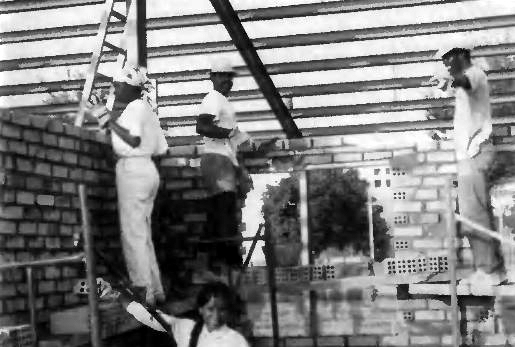
The
Sevilla group became proficient bricklayers in the process of
building their day-care center.
After the orientation, our large group divided and dispersed to three different locations. We stayed in the town of Alcala del Rio, near the city of Sevilla. Our group of 34 received an official welcome by the local townspeople, headed by the mayor. Each of us was given a welcome packet, including information about Sevilla and a free pass to the local swimming pool throughout our stay. Two of our women participants were invited to judge a beauty contest held as part of the town's festivities. The next day, Sunday, we had the opportunity to attend a Catholic mass and a Mormon service. As a group we dedicated our two working areas and the housing site to God. Each of us got involved in the dedication ceremony by offering a prayer or a reading from the scripture of our own tradition.
Our typical working day started around 5:45 a.m. We got ready and took some breakfast before we left at 6:30 a.m. to drive to our two work sites. About two-thirds of our group went to the village of El Viar to build a day-care center, starting from the foundation. The other 10 people went to the nearby village of Burgillos to continue a project begun by the local people -- building a nursing home for the elderly people of the town. Their work had stopped when their money had run out.
To begin our daily work, we joined in prayer. Few of us had done this kind of physical work. Even with no experience, our people worked hard and put themselves into the job. I felt they had a great desire to complete the jobs they were assigned to do. Our instructions came from local engineers, experts in the field. It was challenging to work with the local people. Their way of doing things was different from what most of us expected, but their kindness and warmth, and also the warmth of the rest of the people in the two villages, made it impossible for us not to develop deep appreciation and feelings for each other.
The villagers were grateful for what we did. Many of them were inspired just by the fact that such a "colorful" group could work so well together and actually accomplish something substantial. Some expressed that through us, they found new hope.
We usually finished our work between 1:30-2:00 p.m. This was the limit because I. of the heat. After clean-up, lunch, and rest, the program continued at 7 p.m. with group meetings, during which we shared testimonies and presentations on religious or cultural topics. We sometimes joined in activities with the villagers and got acquainted with Spanish culture. We visited many cathedrals and some mosques. I learned to enjoy the Arabic style of art.
This year I learned more about the Islamic tradition than I ever had before, through presentations and especially through personal discussions and living with Muslim brothers and sisters. I learned to appreciate people who try to faithfully keep their religious practices taught by their scriptures, such as praying five times a day. They are trying, on a daily basis, to practice what their faith teaches. I think the only point to watch out for is motivation. We need to have love for God and our fellow man first in our hearts. Disaster may result if there is ritual without love being involved. If we have no genuine concern for others and only feel the obligation to keep a certain standard, then the point of the practice is missed. That way we could become fanatic. To put it in other words: Faith without love creates fanaticism.
Listening to different ideas of faith, observing the ways of other people, being together with them at work and at mealtimes, sharing our sleeping quarters -- all together this awakened in me again a deeper understanding of my own belief.
What is the main message taught to us by Father and the Principle? It can easily be put into two words -- unconditional love. The way to achieve that unconditional love is through the path of humility and respect. It is not easy to live such a life because of our sin, but ultimately it is what God is waiting for.
I was inspired by our RYS participants. They were truly interested in God and mankind, and I felt so much goodness coming from within them.
I want to close this testimony with a thought from my diary from my summer in Spain: "Be truthful and honest to your fellowmen and pray for them. Respect each person as a child of God. God has been waiting for this time throughout all the ages."